When it comes to the avian world, there’s no shortage of vibrant colors and complex behaviors. One bird that effortlessly combines these features is the Coppersmith Barbet.
Native to South Asia, this unique species possesses a radiant green body with patches of red and yellow, making it a visual feast for birdwatchers.
The Coppersmith Barbet doesn’t rely on its striking plumage for recognition; it’s also known for its distinctive call. I’ve often heard its repetitive “tuk… tuk… tuk” sound likened to a coppersmith striking metal, and let me tell you, it’s an analogy that holds up in real life!
This rhythmic sound serves as both a territorial announcement and a mating call, adding another layer of complexity to this fascinating creature.
But what sets the Coppersmith Barbet apart from other birds? It’s their nesting behavior. These birds are skilled at carving out their nests in tree trunks using their beaks – an impressive feat not commonly found among all avian species.
So next time you’re out birdwatching or simply taking in nature’s beauty, keep your eyes peeled (and your ears open) for the remarkable Coppersmith Barbet – they’re truly one-of-a-kind!
Physical Characteristics of the Coppersmith Barbet
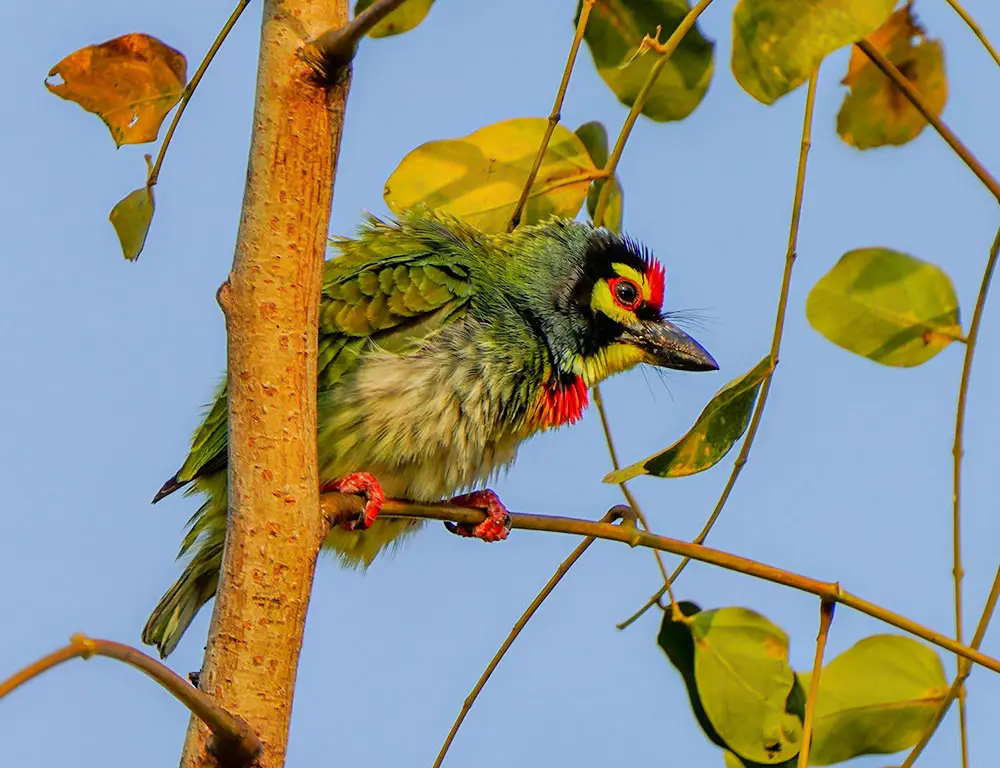
The Coppersmith Barbet (Megalaima haemacephala) boasts a striking array of physical characteristics that make it easily identifiable in its habitat.
Size
Typically measuring 6 to 7 inches long, these birds are relatively small, allowing them to navigate through dense foliage easily.
Color
Their plumage is predominantly green, providing excellent camouflage among leafy trees. However, their heads and breasts feature vibrant shades of red, adding to their visual appeal.
Eyes
With large white eyes outlined in black, Coppersmith Barbets have a distinctive and almost dramatic appearance, resembling stylish eyeliners.
Unique Feature
One of their most notable features is the presence of bristles around their beaks, adding to their unique appearance and possibly serving functional purposes in feeding or communication.
Bill
Their bills are thick and curved slightly downwards at the tip, facilitating their ability to drill holes in tree trunks for nesting—a characteristic essential for their reproductive behavior.
Feet
Like other members of the Barbet family, Coppersmith Barbets have zygodactyl feet, with two toes facing forward and two facing backward. This arrangement gives them excellent grip and stability while perched on tree branches, aiding in feeding and nesting activities.
Habitat and Distribution of the Coppersmith Barbet
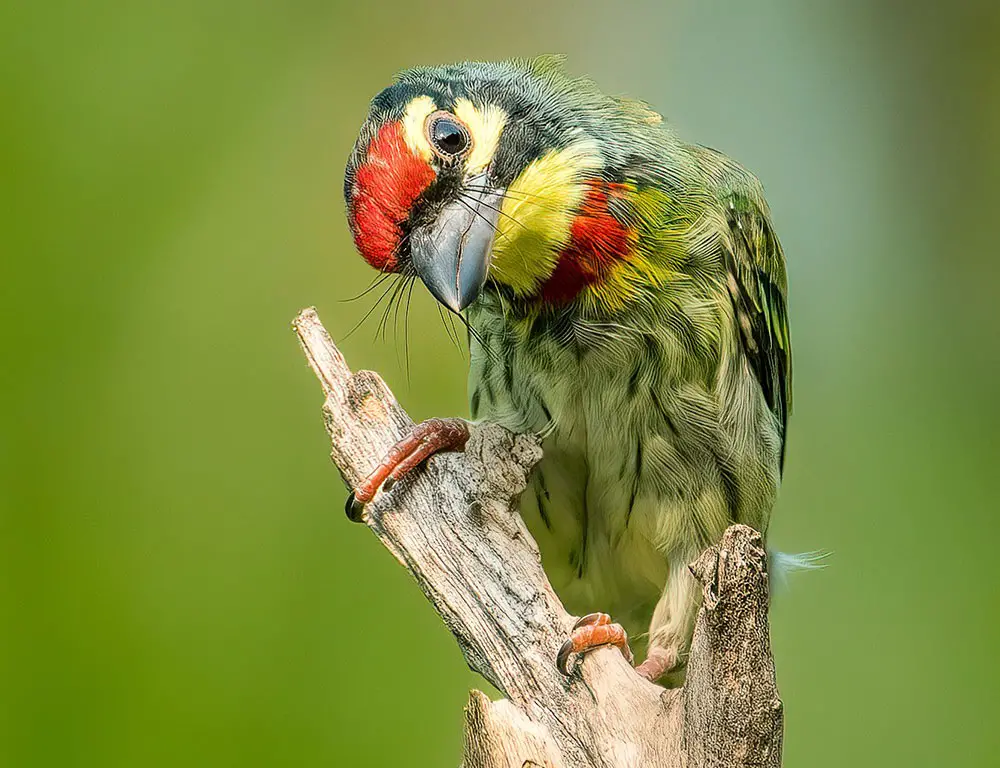
The Coppersmith Barbet (Megalaima haemacephala) is a remarkably adaptable bird species with a diverse habitat range spanning the Indian subcontinent and parts of Southeast Asia.
Its ability to thrive in various environments, from dense forests to urban landscapes, highlights its versatility and resilience.
Habitat
Coppersmith Barbets are commonly found in various habitats, including light open forests, wooded areas, parks, gardens, and urban environments. They prefer habitats with fruiting trees, which provide a reliable food source.
Mango groves, banyan trees, and peepal (Ficus religiosa) trees are among their favored locations due to the abundance of fruits and insects.
Distribution
The primary distribution of Coppersmith Barbets includes:
- India & Sri Lanka: The species is native to the Indian subcontinent and widespread across various regions of India and Sri Lanka.
- Southeast Asia (parts of): Coppersmith Barbets are also native to parts of Southeast Asia, including countries like Indonesia. Their range extends across the region, where suitable habitats are available.
Non-native sightings
Interestingly, Coppersmith Barbets have been observed in regions beyond their typical range. In particular, sightings have been reported in the Himalayan region, where the species is considered non-native.
Despite the colder climate in these areas, Coppersmith Barbets have demonstrated adaptability and have managed to establish populations, albeit outside their natural habitat range.
Diet and Feeding Habits of the Coppersmith Barbet
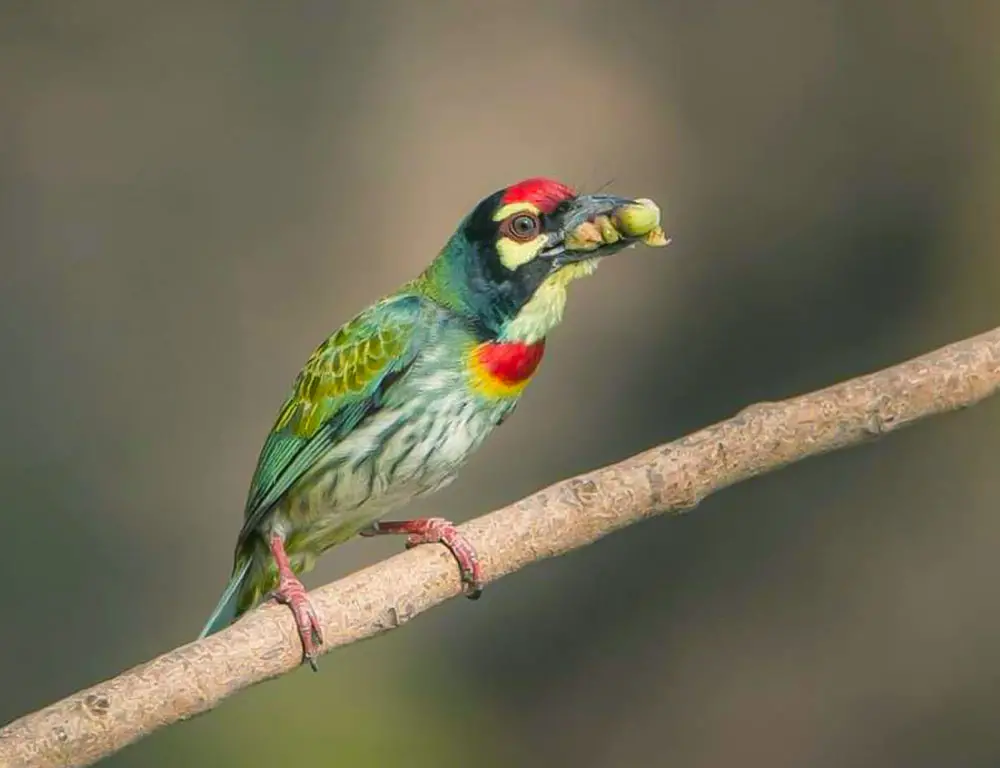
The diet and feeding habits of the Coppersmith Barbet (Megalaima haemacephala) reveal its adaptability and ecological importance within its habitat.
Frugivorous Diet
Coppersmith Barbets primarily feed on fruits, particularly juicy berries and wild figs. Fruits constitute a significant portion of their diet, providing essential nutrients and energy for daily activities.
Insect Consumption
In addition to fruits, Coppersmith Barbets also consume insects. Their sharp, sturdy bills enable them to pry open tree bark to uncover hidden insect larvae, which they promptly devour. This insect consumption serves as an essential protein source and supplements their diet.
Nectar Feeding
Surprisingly, Coppersmith Barbets also indulge in sipping nectar from flowering trees. This behavior demonstrates their adaptability and opportunistic feeding habits, utilizing a diverse range of food sources available in their environment.
Ecological Role
The feeding habits of Coppersmith Barbets play a crucial role in maintaining ecosystem balance. By consuming fruits, they aid in seed dispersion through excretion, contributing to forest regeneration and biodiversity.
Additionally, their consumption of insects, including pests like beetles and wasps, serves as a form of natural pest control, helping to regulate insect populations within their habitat.
Foraging Behavior
Coppersmith Barbets typically exhibit territorial behavior when seeking food. They tend to remain within a specific territory, familiar with the resources available in their surroundings.
This behavior makes them somewhat predictable in their foraging patterns, facilitating their observation by birdwatchers and researchers.
Reproduction and Nesting Behavior of the Coppersmith Barbet
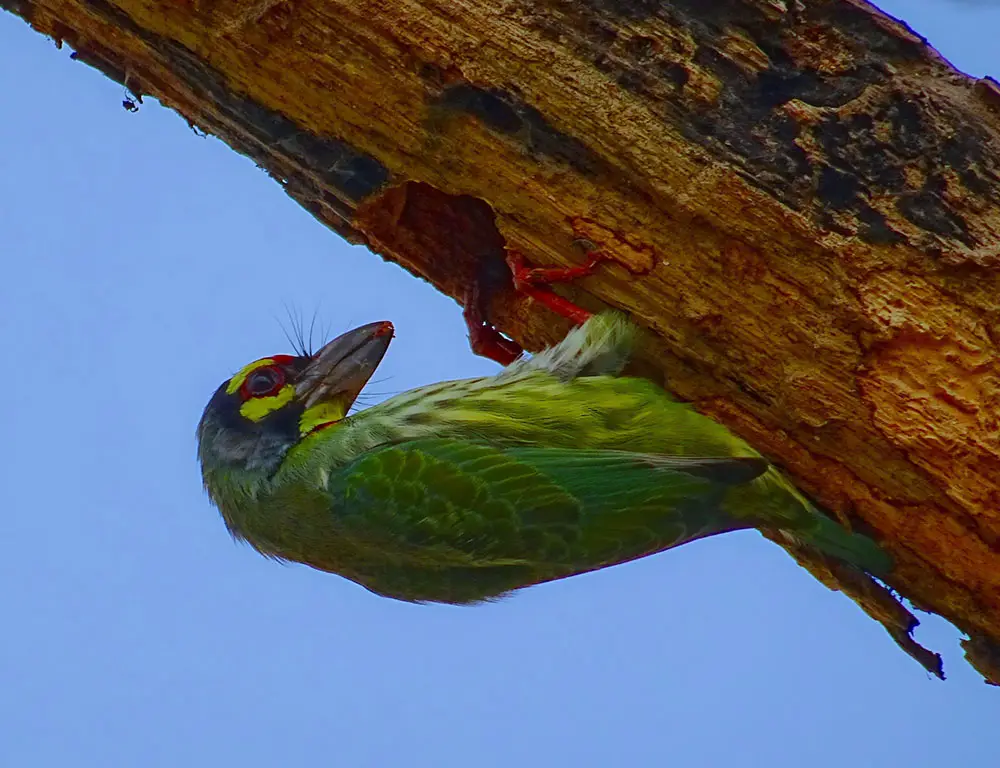
The reproduction and nesting behavior of the Coppersmith Barbet (Megalaima haemacephala) offers a fascinating glimpse into their lifecycle and social dynamics.
Monogamous Behavior
Coppersmith Barbets are typically monogamous, forming long-term pair bonds with a single partner. These bonds often persist throughout their breeding seasons and even across multiple years, showcasing their commitment to their mates.
Breeding Season
The breeding season for Coppersmith Barbets typically spans from February to July. During this time, pairs engage in courtship displays and nest building in preparation for raising their offspring.
Nesting Behavior
Coppersmith Barbets are cavity nesters, meaning they excavate their nests in tree trunks. This laborious process can take up to 20 days to complete. Once the nest is ready, the female lays a clutch of 2-4 eggs, which both parents then incubate.
Incubation and Nestling Care
Both male and female Coppersmith Barbets share the responsibility of incubating the eggs. After hatching, the chicks remain in the nest for about 6-7 weeks under the attentive care of their parents.
During this time, the parents provide food and protection to ensure the survival and growth of their offspring.
Courtship Displays
During courtship, male Coppersmith Barbets perform elaborate displays to attract mates and establish dominance over territory.
This may involve puffing up their feathers, bobbing their heads, and emitting loud calls. These displays serve as signals of fitness and readiness for breeding.
Conservation Status of the Coppersmith Barbet
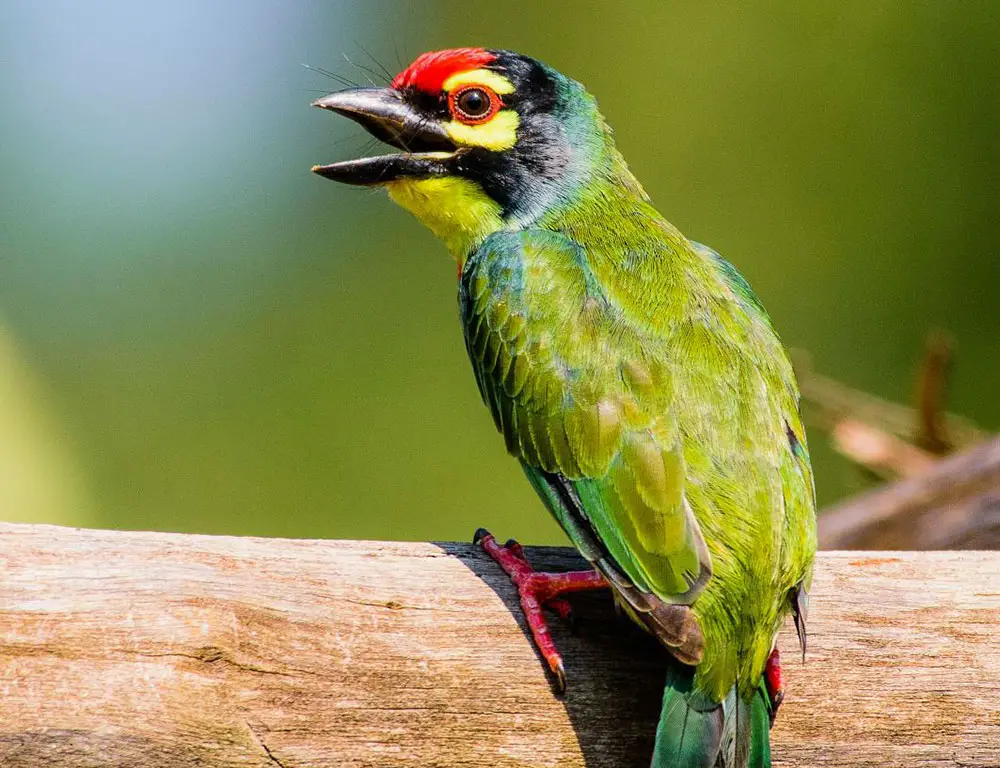
The conservation status of the Coppersmith Barbet (Megalaima haemacephala) is currently assessed as “Least Concern” by the International Union for Conservation of Nature (IUCN), indicating that the species is not facing immediate threats of extinction. However, ongoing efforts are essential to ensure their continued well-being and survival.
Key factors contributing to the Coppersmith Barbet’s stable status include:
Adaptability
The Coppersmith Barbet exhibits remarkable adaptability, thriving in various habitats ranging from forests to urban areas. This versatility reduces its vulnerability to habitat loss, a significant threat many other species face.
Population Trend
While an exact population figure is not quantified, data from BirdLife International suggests that the population trend of Coppersmith Barbets appears stable in recent years. This stability provides reassurance regarding the species’ current conservation status.
Potential Threats
Despite its current status, Coppersmith Barbets faces potential threats that could impact its future stability. These include:
- Pollution: Chemical pollutants and pesticides used in gardens and orchards where Coppersmith Barbets feed on fruits and insects can threaten their health and survival.
- Habitat Degradation: Continued habitat degradation due to urbanization, deforestation, and agricultural expansion could fragment and diminish suitable habitats for these birds.
Conservation Efforts
Efforts to ensure the conservation of Coppersmith Barbets and their habitats include:
- Legal Protection: Many countries have implemented laws and regulations to protect native bird species, including the Coppersmith Barbet.
- Protected Areas: Bird sanctuaries and protected areas provide safe habitats where Coppersmith Barbets can thrive away from human interference.
- Education and Awareness: Educational initiatives raise awareness about bird conservation issues, encouraging people to appreciate and protect avian biodiversity.
Conclusion
I’ve spent a considerable amount of time studying the Coppersmith Barbet, and in that process, I’ve found this bird species to be genuinely fascinating. It’s not just their mesmerizing vivid colors but also their unique behavioral traits and survival skills that make them stand out.
Their ability to drill holes in tree trunks for nesting has always intrigued me. This skill showcases their adaptability and resourcefulness in the natural world.
These birds have a significant role in maintaining our ecosystem, too. They act as seed dispersers, helping grow various plant species. This makes them crucial players in our environment.
Key takeaways from my study on the Coppersmith Barbet:
- Their distinctive call resembles a coppersmith striking metal with a hammer.
- They are predominantly fruit eaters but feed on insects, particularly during the breeding season.
- The ‘Crimson-breasted Barbet’ and ‘Coppersmith’ are other names they’re known by.
- Their lifespan can extend up to 15 years if conditions are favorable.
Regarding conservation status, it’s comforting to know that these birds aren’t endangered at present – they’re categorized under ‘Least Concern’ according to the IUCN Red List. However, continuous deforestation could pose future threats.
As an avid birder, my encounter with the Coppersmith Barbets has been delightful; their vibrant plumage never fails to capture one’s attention! Whether you’re an ornithologist or enjoy observing nature’s beauty, you’ll find plenty of reasons to admire these spectacular beings!